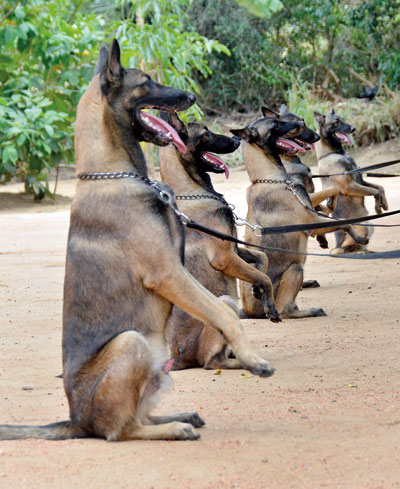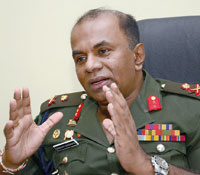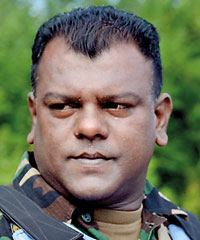Four-legged juniors set for deadly mission
View(s):By Kumudini Hettiarachchi

The ‘juniors’ in training at Boo Oya. Pix by Indika Handuwala
The ‘veterans’ have already been deployed at first light at 6 a.m. on their deadly mission, while their playful ‘juniors’ are still under training back in the camp of the Army’s Sri Lanka Engineers at Boo Oya, Vavuniya.
Having seen the veterans at work earlier in the day in areas marked with the skull and cross bones screaming danger on a large tract of land in Mahamailankulam, the Sunday Times is later privy to the training in progress at the camp.
Sit, legs up, about turn, at ease………as the commands flow, the one-year-old puppies in training are well-versed in what is expected of them, anticipating the next order. Of course, being young, some are tardy, wanting to play rather than train, giving worry lines to their trainers.
This six-month mine-detection dog handlers’ course 2016 had been launched in May, with the components being basic obedience and explosive/mine detection. The nine handler-and-dog teams are Lance Corporal W.D.G. Fonseka & Bruno; Lance Corporal A.G. Wijethilaka & Milo; Sapper D.K. N. Rohan & Gismo; Sapper B.M. Saman Kumara & Lucy; Sapper S.M.A.R. Satharasingha & Emma; Sapper R.P. Nishantha & Penny; Sapper W.A. Ruwan & Sandy; Sapper A.R.I.N. Abeysekara & Lexy; and Sapper K.A.S.P. Perera & Diksi.
The Course Supervisor is Captain Nipun Karunarathna, while the instructors are Sergeants H.T.B. Jayalal and E.G. Chaminda Tushara and Corporal A.M. Chaminda.The ‘juniors’ have been sired by the mine-detection dogs which have been pensioned off. The veteran mine-detection dogs are imported Belgian Malinois.
It is in a small hut close to the mine-clearing site at Mahamailankulam that Captain Kumara Ganegoda takes us through the protocols and the efficient system in place. The de-mining engineers of the Sri Lanka Army have been responsible for 77% of the total of 2,190sqkm cleared of mines so far. The mined area is 2,244sqkm and what remains to be cleared is 54sqkm. Detailed maps show ‘green’ for cleared areas and red for areas still replete with death-dealing mines which come in various forms such as rocket-propelled grenades (RPGs), grenades, anti-personnel (AP) mines, unexploded ordnance (UXOs), detonators and ammunition.
“We not only have a medic cart but also para-medics who have undergone advanced trauma life support training and stretcher-bearers on-site,” says Capt. Ganegoda, explaining that the Vavuniya Base Hospital which is 5.7km away can be reached by them in seven minutes in case of an emergency.
Currently we have 11 working dogs, while one is in retirement, says the Officer-in-Charge of the Mine Detection Dog Section, Capt. Nipun Karunarathne, pointing out that nine more are in training. The routine of the mine detection dogs differs on working and non-working days. On working days, they are out in the field early, returning to camp by 10.30 for a breakfast of milk and eggs. Then it is rest-time in their kennels until a full meal of dog food at 4 p.m. On non-working days, PT (physical training) at 6 a.m. is followed by grooming.

Captain Kumara Ganegoda
While we are chatting that Wednesday, nine of the mine-detection dogs are in the field, five in Mahamailankulam; two in Mullaitivu and two more in Batticaloa. Two dogs are in the kennels as their handlers are on a training course.
We witness the dogs and their handlers at work — after walking the narrow and straight 2m ‘safe path’, with strict instructions not to stray as we are in a minefield — in Mahamailankulam, clearing the land for about 500 families to engage in cultivations, their main livelihood.
The second-in-command of the 8 Field Engineers’ Boo Oya camp, Major A. Janaka Gunawardene says that if the land is being cleared for cultivation the dogs have to sniff out explosives but if it is for people to set up their homes both explosives and even any harmless metal pieces that may have been left behind after the conflict have to be recovered.

Maj. Gen. Dhananjith Karunarathne
“We started playing a different military role, humanitarian de-mining, way back in 2002,” explains Major General Dhananjith Karunarathne earlier when we meet him at the Mattegoda camp, pointing out that the Sri Lanka Army Humanitarian De-mining Unit (SLAHDU) was started then, with support, both technical and instructional from RONCO Consulting Corporation based in the United States of America (USA).
RONCO came through the US State Department to provide basic training and technical know-how, donating equipment as well as 12 dogs, he says, adding that later the US Marshall Legacy Institute did so directly.
In June 2011, MLI had donated six mine-detection dogs through the US State Department, while also offering the services of a Senior Dog Training Instructor from the Global Training Academy (GTA) for dogs. Earlier the dogs and their handlers underwent training at the Sri Lanka School of Military Engineering (SLSME) at Embilipitiya before they faced the United Nations Accreditation Test and passed to commence minefield clearance operations. Now the training has been moved to Boo Oya.

Major Janaka Gunawardene
Maj. Gen. Karunarathne says that the SLAHDU which began operations in 2003 is under the purview of the National Mine Action Centre which currently is under the Resettlement and Rehabilitation Ministry. The directions on what areas to de-mine come through the National Mine Action Centre which works in coordination with regional officials and the District Secretaries.
Explaining the modus operandi when a request for mine-clearance is received, Maj.Gen. Karunarathne says that they conduct a non-technical survey, gathering information from people whether animals have died in explosions in the area. This is followed by ‘identifying’, ‘condensing’ and ‘demarcating’ a typical hazardous area within the larger area. Machines are then deployed to cut down bushes and slowly clear the surface and just below the surface. If explosive devices are unearthed or there is a blast, the area is identified as mined.
There are three vital components in de-mining, the Sunday Times learns – the use of remote-controlled flail machines; the deployment of mine detecting dogs and finally sending in the manual de-miners.
Commending his teams for an excellent job done, he says that while Alvin and handler Lance Corporal G.N.W.M. Nawarathne, having been chosen as the ‘De-mining Team of the Year 2016’ by the MLI will head for Washington DC in October to be treated like royalty, there is a tinge of sadness when he talks of Cairo Spartacus which is no more (it had died on March 21, this year, at six years old) which won the same award with its handler, Sapper D.K.N. Rohan in 2012.

Capt. Nipun Karunarathne
Maj. Gen. Karunarathne had accompanied this team in 2012 for the ‘Clearing the Path’ gala celebration. While the MLI provides accommodation to the handler in a posh hotel, the dog is booked into an animal resort and spa.
In Sri Lanka, meanwhile at the Boo Oya camp there is erected a special monument behind which lies well-tended mounds marking five graves. “They have served our country with devotion and selflessness – those who knew you, will never forget you,” is the lasting and poignant memorial for the special mine-detection dogs which are no more.
Truly, these mine-detection dogs have made life livable for thousands of men, women and children who otherwise would encounter death and serious injury from explosives every day.


